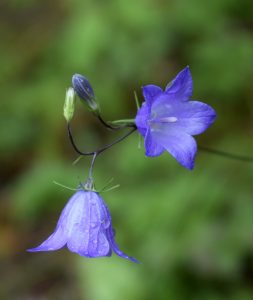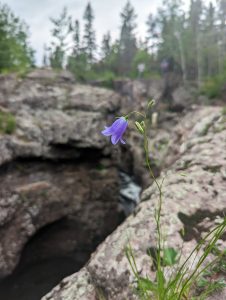Harebell
 Campanula rotundifolia decorates dappled woodlands, open fields and shorelines starting late June into October with gently nodding bell-shaped flowers in a loose raceme at the top of the stem. This is our native harebell, each season a delight to see. Five petals flare slightly out and the style protrudes from the center like a clapper ready to peal out tinkling fairyland music. Five thread-like lobes behind the petals point straight out from the tube-shaped calyx. Despite all that delicateness, harebells grow in the hardiest of places from rocky outcrops and bluffs to open woodlands to the sandy soil of prairie and beach.
Campanula rotundifolia decorates dappled woodlands, open fields and shorelines starting late June into October with gently nodding bell-shaped flowers in a loose raceme at the top of the stem. This is our native harebell, each season a delight to see. Five petals flare slightly out and the style protrudes from the center like a clapper ready to peal out tinkling fairyland music. Five thread-like lobes behind the petals point straight out from the tube-shaped calyx. Despite all that delicateness, harebells grow in the hardiest of places from rocky outcrops and bluffs to open woodlands to the sandy soil of prairie and beach.

Harebell does not exceed 2 feet tall, but you should have no trouble spotting those splashes of eye-catching purple on your outdoor forays. The slender leaves become almost negligible as they climb the stem, starting out larger and more clustered below then narrowing to about 1/16″ inch towards the top. The basal (ground level) leaves are heart-shaped to round and only about 1″ long, fading away by the time the plant begins to flower. From here, several slender stems rise, each one holding the pretty raceme of 3/4″ wide, pale-blue to violet-purple bells standing out roundly in contrast to the narrow leaves and stems.
Harebell is often confused with the non-native creeping bellflower (Campanula rapunculoides) in the same genus and blooming around the same time. Creeping bellflower, however, can become quite invasive, and is on the MN DNR’s “minimal/established” invasive status list. That said, harebell’s invasive cousin is just as pretty in its own way, so if you let creeping bellflower stay, use your judgement on how many you would like in your garden and be wary of too many strays!
